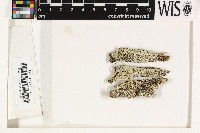
- Home
- Search
- Images
- Species Checklists
- US States: O-Z >
- US National Parks
- Central America
- South America
- US National Parks
- Southern Subpolar Region
|
|
|
|
Family: Lecanoraceae
[Lecanora aemulans Vain.] |
MycoBank no. 362888 Type: Brasil. Minas Geraës: Carassa, 1885, Vainio, E.A. s.n. [= Lich. Bras. Exs. 1380] (Tur-V 5612–lectotype selected by Kalb, in herb.). Description. Thallus corticolous or lignicolous (possibly also saxicolous, see comments below), leproid, almost entirely composed of coarse, granular soredia which develop on the surface of a thin ±contiguous, whitish, membranaceous prothallus over a discolored, ±blackened substrate; granules pseudocorticate, yellowish green to pale greenish beige, somewhat paler where eroded, coarse [±equal in size, (43–)57–71(–114) μm in diam., irregularly aggregating], usually forming a moderately thickened, granular verrucose crust or, if particularly well developed, granules becoming branched, coralloid and forming a thick, secondary, rimose-areolate crust. Apothecia and pycnidia not seen in the Galapagos specimens. Chemistry. Thallus cortex P+ yellow, K+ yellow, KC+ orange, C+ orange, UV+ deep to bright orange; with atranorin [major], thuringione [major], arthothelin [minor], 3-O-methylthiophanic acid [minor]; [specimens analyzed with TLC: Bungartz, F. 4017 (CDS 27947); Aptroot, A. 65707 (CDS 32299), 65170 (CDS 31754)]. Ecology and Distribution. Pantropical; first reported from the Galapagos by Bungartz et al. (2013); occurring in the humid and transition zones, on the bark of native trees and shrubs (Zanthoxylum, Tournefortia), in ±shaded to sheltered as well as sunny, exposed habitats; possibly also on rock (see comments below). Notes. All the Galapagos specimens examined lack apothecia but are chemically identical to V. aemulans. However, only the corticolous collections could be identified with certainty. The two saxicolous specimens were previously tentatively identified as L. expallens Ach. (Bungartz et al. 2011). These specimens have more exuberant thalli composed of ±coralloid granules, more similar to a Leprocaulon than to typical V. aemulans. |

![Vainionora aemulans (Vain.) Kalb [Aptroot, A. 65060 (CDS 31642)] on bark Vainionora aemulans image](/imglib/lichens/CDS_Lichens/00031/CDS_31642_MX_1616_print_1556561940.jpg)

![Vainionora aemulans (Vain.) Kalb [Aptroot, A. 65170 (CDS 31754)] opn rock Vainionora aemulans image](/imglib/lichens/CDS_Lichens/00031/CDS_31754_MX_1618_print_1556562155_tn.jpg)








